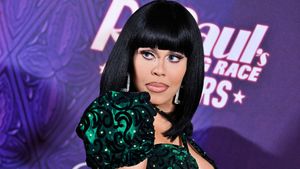I am not a religious man. I don't believe in God. But I do pray.
When I was 10 years old, I visited my uncle's house in Houston, sneaking away to the upstairs den and watching a marathon of MTV's The Real World: San Francisco. Even though we had cable at home, the town I lived in had removed the channel from our programming for its provocative content. Naturally, this only made MTV more appealing, and I watched it every chance I got.
Even at a young age, I was enthralled by the drama and emotion of The Real World. I would picture my 10-year-old self gossiping with Rachel, complaining about Puck, and becoming best friends with Pam in the charmed world of San Fran. I also imagined falling in love with Pedro Zamora and pictured our budding romance playing out in front of the world.
Yes, I was boy-crazy at the age of 10. And next to Patrick Swayze, Pedro Zamora's poster was plastered onto every secret wall in my mind. I watched on the edge of my seat as his romance with Sean Sasser unfolded. This was a world I didn't understand but knew that I was destined to be a part of. And as I fell in love with the dashing Cuban-American man from Miami, my heart broke as I watched him bravely suffer from some disease I vaguely learned about in school called AIDS.
My TV boyfriend was dying. But in the process, he brought HIV and AIDS to the forefront of pop culture. Through his testimony, he made it almost impossible for anyone under the age of 30 to say they didn't know someone with AIDS. He was just one of those people, the kind that you just can't help but fall in love with.
Watching Pedro's storyline unfold on the show was the first time I was forced to confront my identity as a little gay boy. And it was also the first time I felt the panic of what seemed like an inevitable AIDS diagnosis.
It wasn't long before I had to mourn along with the rest of the world over the loss of my first real Hollywood crush. Pedro died just hours after the last episode aired. It seemed like the immoral affection I had for men was an omen of certain doom. It was then that I started to pray. Not to God, but to Pedro, who was my patron saint of love and gay sex.
As I entered my high school, my faith was still strong. But with every real-life boyfriend I collected, the image -- and message -- of my "Real World" began to fade. In my college days, I would often wake in a panic, convinced that I had the virus and it was slowly devouring my body from the inside out. Sitting in my bed, I would talk to Pedro and ask him to protect me. By morning, my panic usually subsided and any thoughts of my AIDS nightmares were dismissed as merely a bad dream.
In my 20s, I would insist on condoms when my clothes were on. Much like other religious men, however, I would see my faith weaken when my clothes were off. But every time I confessed all of my early sexual sins, I tested negative. The more negative tests I received, the less I felt the need to pray. And as the message of Pedro and the rest of the men and women who suffered from AIDS faded into the history books, I began to lose faith in the message he preached.
By the time I turned 26, my life was filled with the ghosts of ex-boyfriends, hazy career aspirations, and arguments over marriage equality. Fears of HIV were replaced by worries about finding a husband. I still knew safe sex was best, but a few missteps every now and then turned into a general belief that the danger of HIV was over. My absent-minded approach to sex and dating reflected it.
I won't bore you with the rest of the narrative. Suffice it to say, it was an HIV-positive diagnosis that brought me back to prayer and to the message of Pedro and so many activists like him.
But what was once a sign of the end was now just the beginning because, even though I had sinned, I was saved. Even though the virus still came with serious consequences, I would live. And even though I was responsible for contracting the virus, I didn't have to give up anything I wanted. My life was given back to me because people like Pedro, my patron saint, and so many others, had died so I could live.
The problem with the message of Pedro is that so many of us got tired of bearing its weight. So we set it down and took a break from HIV. In the interim, an entire generation has emerged unaware and unprepared. As someone who has found the light of my forever MTV crush once again, I believe it is time to bring these kids "to church."
Pedro gave us inspiration and hope. He was a positive force who used education over fear, and he believed in living life to its fullest. It doesn't matter what your faith or sexuality might be -- his teachings, and the teachings of the many others whose spirits have lived on long after their bodies perished, remain strong.
 TYLER CURRY is the senior editor of HIV Equal Online and an award-winning LGBT columnist. Follow him @iamtylercurry
TYLER CURRY is the senior editor of HIV Equal Online and an award-winning LGBT columnist. Follow him @iamtylercurry
































 TYLER CURRY is the senior editor of HIV Equal Online and an award-winning LGBT columnist. Follow him
TYLER CURRY is the senior editor of HIV Equal Online and an award-winning LGBT columnist. Follow him 
















































